Every year I lead a workshop in Death Valley. We offer personalized instruction and photograph some of the many exciting locations there. Click here for more information.
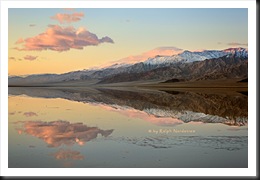 Now, the only time you want to be in Death Valley is late fall through early spring. Otherwise it’s just too darn hot. Personally, I like February. It’s kind of a quite time and we’ve had some mighty good luck the last couple of years with major rainfall in the weeks leading up to the workshop. What this has meant for us is some of the playas were flooded. When that happens you have lakes six inched deep that spread for miles in every direction. It doesn’t take a lot of rain to flood the playas either. Generally an inch will do.
Now, the only time you want to be in Death Valley is late fall through early spring. Otherwise it’s just too darn hot. Personally, I like February. It’s kind of a quite time and we’ve had some mighty good luck the last couple of years with major rainfall in the weeks leading up to the workshop. What this has meant for us is some of the playas were flooded. When that happens you have lakes six inched deep that spread for miles in every direction. It doesn’t take a lot of rain to flood the playas either. Generally an inch will do.
There are some locations in Death Valley that I really love and I’d like to share them with you.
Zabriskie Point
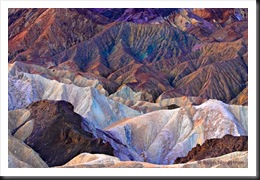 I think Zabriskie Point is my absolute favorite place to shoot in Death Valley. I remember the first time I shot there. It was during the first workshop I ever attended and I was really overwhelmed. All I could see was an intimidating expanse of badlands eroded into chaotic forms. I didn’t notice the subtle colors in what appeared to be uniformly tan mudstone. But I did my best and actually came away with a couple of winners.
I think Zabriskie Point is my absolute favorite place to shoot in Death Valley. I remember the first time I shot there. It was during the first workshop I ever attended and I was really overwhelmed. All I could see was an intimidating expanse of badlands eroded into chaotic forms. I didn’t notice the subtle colors in what appeared to be uniformly tan mudstone. But I did my best and actually came away with a couple of winners.
I prefer shooting Zabriskie before sunrise, especially if a golden glow is developing in the eastern sky. I like this light the best and for a long time, while I shot both sunrise and sunset, I only got photographs that I really liked from sunrises. But that’s changed in the past year or two. Still, my favorite light still is the twilight you get when the sun is below the horizon, whether that be the eastern or the western horizon.
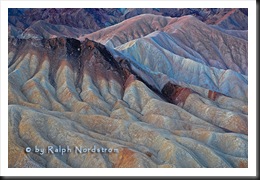 As I’ve grown more familiar with Zabriskie Point I’ve begun to realize the fantastic abstracts one can make there. And these abstracts can take on a wide range of moods from harsh chaotic scenes to comforting peaceful ones. So Zabriskie point is always worth two sessions whenever I’m in the valley – sunrise and sunset.
As I’ve grown more familiar with Zabriskie Point I’ve begun to realize the fantastic abstracts one can make there. And these abstracts can take on a wide range of moods from harsh chaotic scenes to comforting peaceful ones. So Zabriskie point is always worth two sessions whenever I’m in the valley – sunrise and sunset.
My plan is to take a weekend and spend the whole time at Zabriskie from the dark of dawn to the dark of dusk. I want to see it in its best light and its worst light (if there is such a thing). I think that would be a wonderful experience and I would learn a lot about this magical place.
Devils Golf Course
Devils Golf Course is a really strange place. If you want chaos this has it in spades, even more so than Zabriskie Point. It’s arguably the most intimidating place to shoot in the Valley. It’s a seemingly endless sea of large slabs of salt six inches thick that are fractured and shoved up against each other. It’s also a very risky place to walk. The footing is very uneven and falling on the salt would be like falling on lava with the added pain of having salt rubbed into your wounds.
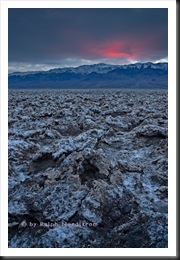 It’s also a very hard place to photograph, at least I haven’t gotten the knack of it yet. That’s not to say that there aren’t some great shots out there; there definitely are. But you’re going to work to find them.
It’s also a very hard place to photograph, at least I haven’t gotten the knack of it yet. That’s not to say that there aren’t some great shots out there; there definitely are. But you’re going to work to find them.
I don’t have any favorite time of day except that I’d probably stay away from mid-day. Sunrise and sunset would probably work just the same. I wouldn’t try walking out there in the dark though. That wouldn’t be very smart.
This photograph was taken at the end of a overcast, rainy day. We were very fortunate that the sky to the west was just barely starting to clear and the sun turned the clouds delicate a rose color for, oh, maybe 60 seconds. I also felt fortunate to have found a foreground that had something of a leading line to draw the eye into the image. Given the unlikelihood of the weather and the difficulty of the location, it turned out pretty well. But boy, you really get the sense of the salt chaos going on forever, don’t you.
Mesquite Flats Dunes
Photographing sand dunes can be more challenging that it would seem. First, if there’s any breeze at all you need to be really careful about getting sand in your camera and lenses. I encourage people to decide what lens they will be using before they head out on the sand and plan on not changing it once they get out there. If the conditions are calm then if you’re very careful you can change lenses. But personally I’m very cautious of that. I just keep thinking what would happen if a tiny grain of sand got stuck in the camera’s shutter mechanism.
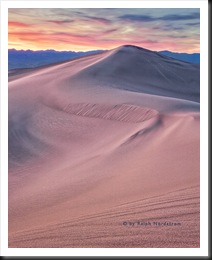 Both wide angle and telephoto lenses work well on the dunes. Wide angles will give some great near-far compositions while telephotos will allow you to zero in on interesting vignettes.
Both wide angle and telephoto lenses work well on the dunes. Wide angles will give some great near-far compositions while telephotos will allow you to zero in on interesting vignettes.
The Mesquite Flats Dunes are situated in such a way that they are good for both sunrise and sunset. I prefer sunrise as any breeze during the night may have wiped out some of the thousands of footprints that accumulate there. And if you’re fortunate to have a hard blow overnight and a calm morning you’ll have pristine dunes to photograph.
Like I said, I prefer sunrise but that poses the challenge of walking the half mile or so across the desert in the dark to be in position when the light begins to break. It’s a thrill to have them appear before you just as the sky becomes bright enough to see outside the little pool of light created by your headlamp.
Dunes offer compositions that include line, form, pattern and texture. In fact, dunes offer pretty much the opposite of the chaos of Zabriskie Point and Devils Golf Course. Curved lines abound. Ripples of sand provide wonderful patterns with fascinating textures when the sun is low in the sky.
Dante’s View
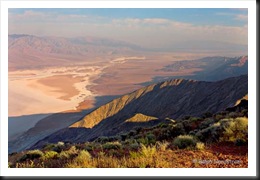 If you want a grand view of the Valley, Dante’s View is one of the best locations. It’s right above Bad Water and Telescope Peak is directly across from it. To the right the valley is laid out below you and disappears into the desert haze. The great salt pans make winding patterns on the Valley floor.
If you want a grand view of the Valley, Dante’s View is one of the best locations. It’s right above Bad Water and Telescope Peak is directly across from it. To the right the valley is laid out below you and disappears into the desert haze. The great salt pans make winding patterns on the Valley floor.
I’ve shot Dante’s View at both sunrise and sunset. I tend to prefer sunrise (there seems to be a pattern here). Telescope Peak and the Panamint Range will get first light at sunrise. At sunset they’ll be in deep shadow although if there is a bank of spectacular clouds that pop when the sun gets under them you wouldn’t want to miss that.
This is a perfect location for panoramas. From up here one can really get the feeling of how vast Death Valley really is. It’s also fascinating to sit up here and try to imaging what the Valley looked like 10,000 years ago at the end of the ice age when it was filled with Lake Manley. The lake stretched more than 100 miles from south to north and must have been an awesome sight.
In February it may not be possible to get up there. Dante’s View is high enough that a passing winter storm could drop snow on it and the road would be too icy. The park rangers will have the road closed if the conditions are too dangerous so it’s best to check at the park visitor station in Furnace Creek before heading up.
Racetrack
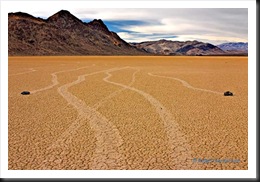 One of the highlights to any trip to Death Valley is a visit to Racetrack Playa. It’s not always possible to get back there and not just because of the rough 27 mile drive dirt road. The playa can be flooded if there has been any appreciable rain. And when it’s flooded you can’t go out on it.
One of the highlights to any trip to Death Valley is a visit to Racetrack Playa. It’s not always possible to get back there and not just because of the rough 27 mile drive dirt road. The playa can be flooded if there has been any appreciable rain. And when it’s flooded you can’t go out on it.
Back to the road. To give you an idea of just how rough it is the Park Service recommends you take two, that’s right, two spare tires with you . In the two times I’ve been back there to date I’ve heard of two vehicles with punctured tires. Fortunately they weren’t mine.
Racetrack Playa gets its name because the playa is shaped like an oval race track and at the north end an outcropping of rock forms the grandstand. In fact, that’s what it’s called – the Grandstand.
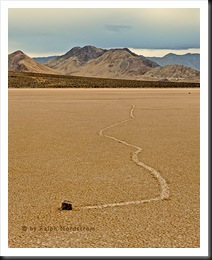 But if it weren’t for the mysterious moving rocks few people would hazard a trip back there. The rocks come tumbling off a cliff at the south east corner of the playa and then move literally for miles leaving trails behind them. It’s obvious from the trails that the playa surface was wet and slick when the rocks moved. But what’s not so obvious is how they move. No one has ever observed them in motion but many theories abound and the debate continues to this day in the geological community. My favorite theory is that they are blown around by very high winds during severe winter storms.
But if it weren’t for the mysterious moving rocks few people would hazard a trip back there. The rocks come tumbling off a cliff at the south east corner of the playa and then move literally for miles leaving trails behind them. It’s obvious from the trails that the playa surface was wet and slick when the rocks moved. But what’s not so obvious is how they move. No one has ever observed them in motion but many theories abound and the debate continues to this day in the geological community. My favorite theory is that they are blown around by very high winds during severe winter storms.
The rocks still move on a fairly regular basis. In general they’ll move within a three year period. In other words, rocks that were tagged were found in a different location a couple of years after the tagging.
I’ve only photographed this location during late afternoon. The sun will set behind the peaks to the west fairly early so you can photograph in nice soft light. You’ll probably walk several miles across the playa in search of the rocks as the playa is very large and the rocks are spread out.
One disturbing thing you’ll see is that the rocks are getting carried off by thoughtless people. In fact I’ve seen vehicle tracks on the playa where people have driven out there to make it easier to pilfer the rocks. Not only are they disgusting, greedy people but they’re lazy to boot.
A dream of mine is to spend the night out there in the campsite about a half mile south of the playa. That way I could get both a sunset and sunrise. I think that would be awesome.
There are many more places to photograph in Death Valley that I haven’t touched on here. We catch these and others in our three day Death Valley workshop. In 2011 the dates are February 12-15. Come along and join the fun. Click here for more information.
Join me on an upcoming workshop. Click here for more details.
To see more of my photographs click here.
(5591)

Ralph,
I have been thinking about joining you at Death Valley. This post clinched it for me. I have down loaded a registration form and will be sending it in soon.
Thanks,
Larry Lindell
Thanks Larry. Looking forward to seeing you again.